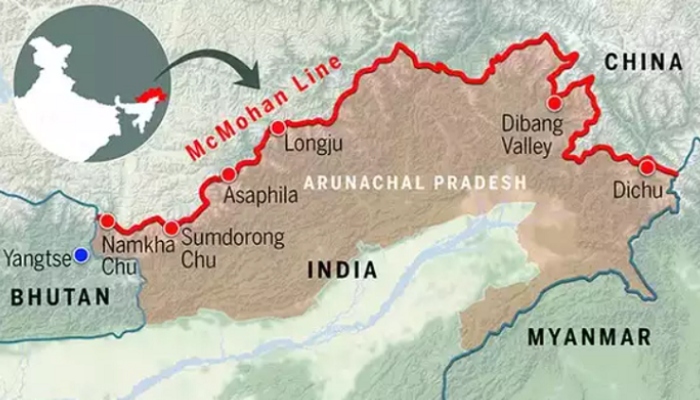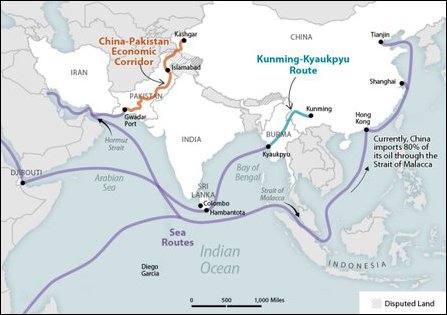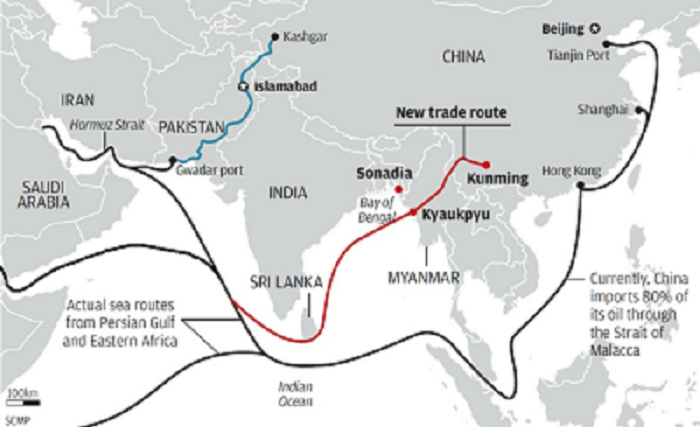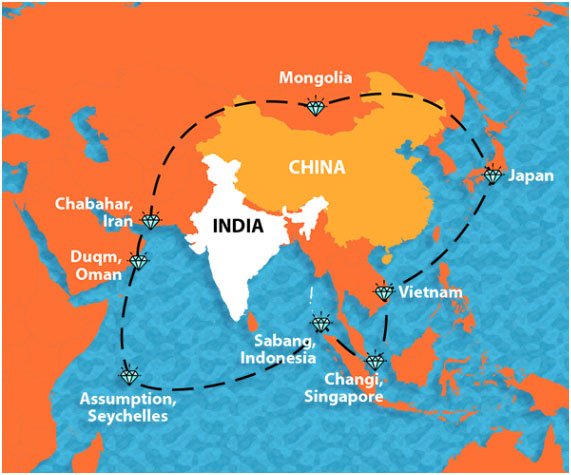International Relations Class 09
REVISION OF THE PREVIOUS CLASS (5:10 PM):
Recent Phase Of India-China relations:
- Bilateral relations have hit their lowest point(Nadir) since the 1962 war.
- We have seen many border clashes.
- There have been many Chinese skirmishes after October 2021 in Arunachal Pradesh.
- There have been earlier incidents at Depsang Valley in 2013, and Chumar region in 2014.
- These incidents were accidental, unlike the pre-mediated event at the Galwan Valley in June 2020.
- India rejected both signals by mirroring the military buildup of Chinese forces along the borders.
- India tried to inflict economic costs on China, but Indian economic cooperation with China has only increased.
- India-China trade deficit is expected to grow to $ 100 billion this year.
- India is the largest recipient of grants from the Beijing-led Asia Infrastructure Investment Bank (AIIB)
Yangtse Ridge:
- India first occupied this area in 1986 following the Sumdorong Chu conflict.
- It offers an unrestricted view of the entire Tawang Valley and Bum La Pass ( the pass between Tibet and Tawang).
- Crucially, India's control of the ridge line allows control over the Sela Pass.

- Sela Pass is the only mountainous access in and out of Tawang.
- Sela Pass is the only mountainous access in and out of Tawang.
- Such a Chinese skirmish on the Yangtse Ridge in October 2021 was pushed back by India.
- But presently, PLA's construction of a road and military camp around 500 feet off the ridge allowed for the escalation.
Indian responses:
- India has tried both internal and external balancing against China.
Internal Balancing:
- Increased surveillance along the borders: use of satellites, long-range unmanned aerial vehicles, radars, etc.
- Equipping the army with modern weapons.
- Developing infrastructure along the border with greater emphasis along the eastern sector.
External Balancing:
- Cooperation in the Indo-Pacific region with many world powers.
- Joint military exercises such as:
- I. Yuddh Abhyaas with the USA in Auli, Uttarakhand.
- II. Pitch Black exercise with the Australian air force.
- III. Malabar exercise, erc.
- Indian steps have not yet given us the desired results because of the large economic power differential with China.
What else India should do?:
- India faces an escalation trap:
- The rapid Infrastructure development along the borders has created an escalation trap for India.
- It is difficult for India to respond to it without being seen as escalating the situation.
- Also, it is not without strategic concerns that India may not take infrastructural development.
- This is the dilemma faced by the government of India.
- Increasing vigilance and readiness along the border is one way to manage the dilemma.
- India should position the recent border skirmishes as a significant threat to peace and order in the Indo-Pacific.
- Thus, India should seek support from the international community to call out China's provocations along the border.
- Develop India's economy and the manufacturing sector's competitiveness to increase its contribution to the national GDP through schemes such as Make in India, Production-Linked incentive schemes, etc.
- It is because of the significant economic lag that has encouraged China to commit military aggression against India.
- To effectively decouple the Indian economy from the Chinese economy.
- Since India is dependent on critical imports from Beijing such as Active Pharmaceutical Ingredients(API), electric and electronic goods, etc. a knee-jerk reaction of cutting Chinese exports to India may lead to losses for New Delhi.
- India is a $3 trillion economy and is trying to take adverse actions against a $17 trillion economy that is more likely to inflict injury on India than China.
How to do Economic Decoupling with China?:
- India needs to identify critical inputs imported from China that can be produced in India at cost-effective rates like the APIs.
- India should try to conclude Free Trade Agreements to expand its trade.
- Encourage the domestic production of arms and ammunition necessary for India's security.
- No country can become a regional or a global power by being completely dependent on imports of its defense products.
- As Indian and Chinese armies compete along the border, it is important to pursue non-military and multilateral measures in parallel to reduce the risk of accidental escalation.
- We need to promote operational synergy between the Indian army and the paramilitary force Indo-Tibetan Border Police( ITBP).
Conclusion:
- India aims for a multipolar world order and wants to be part of both the global north and the global south.
- It can only be accomplished if India is able to exercise strategic autonomy.
- However, its border disputes with China have forced India to view all its foreign policy choices through the Chinese lens.
- India should consider closer cooperation with the USA and the West without being overly worried about provoking China.
- It is such cooperation that would augment India's power vis-a-vis Beijing.
- If no early resolution, India should prioritize peace among the borders with China.
- It is essential to realize Indian economic growth potential and secure its national interests in the changing world order.
- Indian economic resurgence would depend upon the resurgence of the Indian manufacturing sector.
1914 SHIMLA CONFERENCE (5:35 PM):
- Representatives of British India, China, and Tibet to settle the border dispute of the eastern sector.
- Tibet had declared independence from the Qing dynasty in 1912.
- China left the Conference and the final settlement was signed between British India and Tibet.
- Tibet recognized Indian sovereignty over Arunachal Pradesh.
- China will never leave its claim over Aksai Chin despite the region being inhospitable.
- This is because Aksai Chin provides all-weather connectivity between Tibet and Xinjiang(both restive provinces).
Macmahon Line:
- Between India and China.

Johnson Line:
- Between India and Tibet.
- China does not recognize this line and instead proposes the MacDonald Line( present-day LAC).
- China considers Arunachal Pradesh as Southern Tibet.
- China claims the Tawang region due to Buddhist claims.
- Tawang Valley is the only fertile area in the region.
- China also seeks the large hydropower potential of Arunachal Pradesh.
Dams Of Brahmaputra River:
- China refers to the Brahmaputra as the Yarlung Tsangpo River.
- The river enters India as Siang in Arunachal Pradesh.
- Siang meets Lohit and Dibang and we get to the Brahmaputra river.
- After the Chinese annexation of Tibet, China became the upper riparian state with respect to the Brahmaputra.
- Being an upper riparian state, India is apprehensive that it may harness the river's waters even to India's disadvantage.
- The Brahmaputra is the lifeline of northeastern India.
Dam-building activity by China:
- Previously in 2010, China began the construction of the dam in the upper and middle reaches of the river.
- it has already built the Zangmu Dam while three other dams Dagu, Jiexu, and Jiacha are being developed.
- Recently, China announced its plans to develop 60 Gigawatts dams on the lower reaches of Brahmaputra.
- It is likely to be built in Medong county where the river drops by 2000 meters before it takes a sharp turn to flow into Arunachal Pradesh.
Concerns of India:
- I. Previously, India has expressed concerns over it, however, the dams on the upper and middle reaches greatly impact the quantity of Brahmaputra's water flow because:
- (a) They are run off the river projects.
- (b) The Brahmaputra is not entirely dependent upon the upstream flows:35% of the river's basin lies in India.
- (c) Though a perennial river, only 18% of the river flow is contributed by the glacial melt in Tibet.
- The Brahmaputra is a substantially rain-fed river with monsoonal rains in India contributing to the river's flow.
II. The recent announcement over building a dam in Medong county has raised fresh concerns for India because:
- Its location is close to the India-China border.
- Its potential impact downstream:
- Though China has claimed it to be a run-off- river project, its location close to Arunachal Pradesh, experts say could still impact the water to India.
- Also, India fears the release of water during the monsoons which could inundate or flood Assam which already faces severe floods during monsoons.
- Use of water as a weapon:
- During the times of standoff between the two countries, China might alter the water flow into India.
- Previously during the Doklam standoff in 2017, China suspended sharing hydrological data during the monsoonal months of May to October with India.
III. Seismological impact:
- The region is prone to earthquakes, landslides, and other related problems.
IV. Ecological impact:
- Particularly in the context of the sensitive Himalayan ecosystem and the downstream ecology.
- Sediments carried by the river which is important for agriculture in Assam could be impacted.
Response of the Indian government:
- India has expressed that China must be mindful of the interests of the downstream states.
- India is considering a 10-gigawatts hydropower project in the Dibang Valley to mitigate the adverse impact.
Way forward:
- India should push for a comprehensive river water treaty over the Brahmaputra.
- Pending such a treaty, India must use the available technological resources, satellite imagery, etc. to monitor the river water flow in the Brahmaputra.
- India can use co-riparian Bangladesh which will strengthen India's position.
BELT & ROAD INITIATIVE (BRI) (6:00 PM):
- It is an initiative of Xi Jinping.
- It is also called the One Belt One Road project.
- The One Road leg represents the 21st-century Maritime Silk Route.
- The One Belt leg represents the Silk Road Economic Belt (SREB).

Reasons for BRI:
- I. Chinese motive to counter its Malacca Dilemma under which China seeks to diversify its connectivity for energy security without being over-dependent on the strait of Malacca.

- II. BRI is also a medium to invest the capital that China has accumulated due to the stimulus that was launched after the 2008 Financial crisis.
- III. BRI will push development into the central provinces of China.
- The China-Pakistan Economic Corridor(CPEC) aims to develop the landlocked Xinjiang province.
- The China-Myanmar Economic Corridor(CMEC) aims to develop the landlocked Yunnan province.
- BRI will help in achieving an economic interdependency among various nations, with China being the senior partner.
- IV. BRI is a very important component of Chinese peripheral diplomacy under which China seeks to exert influence over its neighbors.
Criticisms of BRI/Reasons for India not joining BRI:
- Debt trap: It is alleged that China deliberately pushes developing countries into financially unviable projects.
- After the underwhelming performances Of Gwadar Port and Hambantota Port, the allegations have gotten stronger.
- Opaque decision-making: There is a severe lack of transparency in the Chinese handling of the project.
- There is no single ministry coordinating the project; there is not even an exhaustive list of projects that are undertaken under BRI.
- Non-participation of the Private sector: The projects are undertaken by Chinese public sector enterprises as per their terms.
- Neo-Imperialism as China is getting equity in return for loans.
- The CPEC passes through Gilgit-Baltistan, which violates Indian territorial sovereignty.
- India has joined other Chinese initiatives though like AIIB, CSAFC, etc.
Western alternatives to BRI:
- Build Back Better World (B3W) is an initiative undertaken by the G7 for transparent funding of infrastructure projects in developing nations.
- B3W was remodeled as Partnership for Global Infrastructure and Investment (PGII) in 2022.
- PGII aims to be a value-driven, high-impact infrastructure-building initiative in low and middle-income countries in the Asia-Pacific.
- PGII aims to invest $600 billion by 2027.
- Four Pillars of PGII:
- I. Green /Clean Technology.
- II. Information & Communication Technology.
- III. Gender Equality & Equity.
- IV. Global Health Infrastructure
Differences between PGII & BRI:
PGII BRI Invests only in clean energy.
Invests in Coal-fired power plants PGII will use public finance(govt funding) which would catalyze private funding. Uses State funding It will prefer including local workers and contracted companies. Chinese funding is given through loans and all workers and contracted companies are Chinese Transparent Funding Opaque funding - India is a beneficiary of PGII.
- Three projects have been started under PGII:
- I. Vaccine Development facility in Senegal.
- II. M-RNA Vaccine Development facility in Latin America.
- III. $30 million dollars to Omnivorve Agritech and Climate Sustainability Fund, an Indian initiative.
Blue Dot Network (BDN) 2019:
- It is an initiative formed by the USA, Japan, and Australia under the Indo-Pacific Business Forum.
- BDN will evaluate financial transparency, environmental sustainability, and impact on economic development.
- BDN has no funding mechanism as such.
ADVERSE BALANCE OF TRADE (6:35 PM):
Financial Year Trade Deficit in billion dollars 2020-2021 71 2021-2022 73 2023-2024 100 (expected)
Reasons for the high trade deficit:
Narrow Trade basket:
- India mainly exports raw materials like iron ore, cotton, copper, aluminum, diamond, and natural gems.
- China mainly exports value-added goods like electrical machinery, inorganic chemicals such as API (Active Pharmaceuticals Ingredients), etc.
- China has restricted its markets for the products in which India is competitive like agricultural exports, pharmaceuticals, IT services, etc.
Way forward for India:
- Increase the competitiveness of India's manufacturing sector.
- Reduce logistic costs which are 13-14% of the GDP in India and 8% in China.
- Second-generation economic reforms such as labor reforms.
- Boosting the Indian manufacturing sector's output which has been stagnant at 15% of the GDP, for much time.
- Demanding greater market access for goods in which lies India's expertise.
- India can also look for Chinese funding in certain non-strategic areas.
China in the Indian Ocean region:
String of Pearls:
- The term was coined by American defense contractor Booze Allen Hamilton.
- It is a geopolitical strategy by China to expand its naval presence by building civilian maritime infrastructure along the Indian Ocean periphery.

- It will keep a check on India.
- This will also help China overcome its Malacca Dilemma.
Indian response:
- India is trying to come up with its own Necklace of Diamonds strategy.

INDIA- SOUTH EAST ASIA RELATIONS(7:05PM):

- Historical Ties:
- Historically, India enjoyed close relations with South-East Asia.
- South Asian Kingdoms such as the Chola empire had vibrant trade ties with South East Asia.
- Along with trade, there was an exchange of :
- I. Religion- Buddhism and Hinduism.
- II. Language- Sanskrit.
- III. Customs- Brahmanical traditions.
- IV. Mythology- Ramayana.
- South-East Asia was referred to as Greater India by Pandit Nehru in his classic Discovery Of India.
During the Cold War:
- The relations were tepid.
- South East Asia was under the USA camp while India was a leader of NAM with a tilt towards USSR.
Capitalism:
|
- Closed Economy: Even the Southeast Asian countries were economically weak and politically unstable.
- Indian land bridges to South Asia were interrupted- East Pakistan was hostile while Myanmar had a junta (military government) that India did not recognize.
INDIA SOUTH EAST ASIA RELATIONS AFTER COLD WAR (7:35 PM):
- India launched the Look East Policy in 1992 under PV Narasimha Rao.
- The aim was to build economic relations with South East Asia.
Determinants of Look East Policy:
- India lost its trusted ally and primary economic partner after the USSR disintegrated.
- So India was in search of new partners.
- India adopted the New Economic Policy and undertook LPG reforms.
- The Tiger Economies of South East Asia emerge as attractive economic partners of India.
- The USA emerged as a single superpower, and so India wanted to befriend the USA through its allies.
- India was in a way"looking east to look west".
- SAARC failed to emerge as a platform for regional economic cooperation.
- Therefore, India needed to look towards its extended neighborhood for economic cooperation.
- To balance China in its backyard of South East Asia.
- The USA(a prominent external power) and even the nations in the regions have very well received the policy.
- This is because India presented a democratic, non-threatening counterbalance to the Communist expansion by China.
- Look East Policy is believed to be the most successful Indian foreign policy.
- India has been able to punch above its weight in this region.
India- ASEAN relations:
- ASEAN members include Myanmar, Thailand, Laos, Cambodia, Vietnam, Malaysia, Singapore, Indonesia, Brunei & Philippines.
- East Timor has been admitted in principle to ASEAN.
- Papua New Guinea also wishes to join ASEAN but it is denied due to the Pacific island status of Papua New Guinea.
Indian Political Association (timeline):
- 1992- Sectoral Dialogue partner.
- 1995- Full Dialogue partner.
- 2002- Summit-level partnership.
- 2012- Strategic partnership.
- 2022- Comprehensive Strategic partnership.
Indian Economic Association (timeline):
- 2009- FTA in goods was signed.
- 2015- India-ASEAN Free Trade Area(for goods, services and investments was finalized.
India in ASEAN-led groupings:
- I.ASEAN Regional Forum(ARF):
- It was the first regional security partnership in the region.
- II. India is a founding member of the East Asia Summit(EAS).
- It consists of 10 ASEAN members, Australia, New Zealand, Japan, South Korea, China, India, USA, and Russia.
- India is not an East Asian country but despite that, India was accorded a founding membership of the EAS.
- In comparison, the USA became a member only in 2008.
- This accorded the importance of India as a balancing power in the region.
Regional Comprehensive Economic Partnership (RCEP):
- It was envisaged as a comprehensive economic partnership between ASEAN and its 6 FTA partners.
- In November 2019, India withdrew from the negotiations.
The topic for the next class is the reason why India opted out of RCEP.
1)
Malacca strait is located between
(a)India and Thailand
(b)Thailand and Myanmar
(c)Indonesia and Malaysia
(d)Indonesia and Vietnam
2)
Which of the following initiatives have been taken under western response to the Chinese One Belt One Road initiative ?
1. Blue Dot Network.
2. Build Back Better World (B3W).
3. Wassenaar Agreement.
4. Partnership for Global Infrastructure and Investment (PGII)
Choose the correct answer from the codes given below:
(a)1,2, and 3 only
(b)1,2,and 4 only
(c)2,3 and 4 only
(d)1,2,3 and 4
3)
Which of the following are the major criticisms of the Chinese One Belt One Road initiative ?
1. Opaque decision-making.
2. Debt Trap Agreements
3. Fully Private Partnership
Choose the correct answers from the codes given below:
(a)1 and 2 only
(b)2 and 3 only
(c)1 and 3 only
(d)1,2 and 3
4)
Which of the following is the best description for Zangmu, Dagu, Jiexu, and Jiacha ?
(a)Artificial islands built by China in the South China Sea.
(b)North Korean missile testing sites
(c)Chinese dam projects on the Brahmaputra river.
(d)Types of cryptocurrency
5)
Consider the following statements with respect to the Yangtse Ridge:
1. It has been under Indian control since the 1986 Sumdorung Chu conflict.
2. It provides access to both Tawang Valley and Bum La Pass.
3. Its control provides India with access to the Sela pass
Choose the correct statements out of the codes given below:
(a)1 and 2 only
(b)1 and 3 only
(c)2 and 3 only
(d)1,2 and 3
6)
Which of the following were the results of the restrictions imposed on India China bilateral trade?
1. India- China bilateral trade has reached a time high.
2. The fiscal deficit is in India"s favor.
3. Most of the Active Pharmaceutical industries have relocated from China to India.
Choose the incorrect statements from the codes given below :
(a) 1 and 2 only
(b)2 and 3 only
(c)1 and 3 only
(d)1,2 and 3
7)
Consider the following statements with regard to the Association of Southeast Asian Nations (ASEAN):
1. Indonesia
2. Malaysia
3. Philippines
4. Singapore
5. Thailand.
How many of the above countries are the Founding members of ASEAN?
(a)Only two
(b)Only three
(c)Only four
(d)All the five
8)
Which of the following country was admitted in ASEAN in 2022 as "in principle" as the organization"s 11th member?
(a)East Timor
(b)India
(c)Papua New Guinea
(d)Laos
9)
Write a short note on Belt and Road initiative mentioning India"s position on such connectivity projects. (150 words/ 10 marks)
10)
What in your opinion are the reasons why China is so confident regarding it"s aggressive territorial policy with respect to India ?(150 words/10 marks)
11)
Elucidate the Indian apprehensions regardig the Chinese upper riparian position for Brahmaputra river. (150 words/10 marks)
12)
What has India done to counter the increasing Chinese aggression in the recent times ? How effective have the steps been ? (150 words/10 marks)
Answers
1) c
2) b
3) a
4) c
5) d
6) b
7) d
8) a
Identify the key issues on river water of the Brahmaputra between India and China. Also, suggest a framework for the management of these issues and an eventual resolution. (10 Marks/150 Words)
(10 marks)



0 Comments